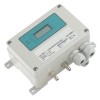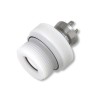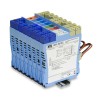2 wire is used to distinguish electrical connections for measurement signals which use only two connections for carrying both the power supply and signal. The most common example is a 2 wire 4-20mA current loop output.
2 wire is also used to describe a resistive thermometer that is wired so that there is no compensation for errors caused by the connecting wire on each side of the resistive thermometer. Therefore a 2 wire connected resistive thermometer will be less accurate than 3 wire, or 4 wire compensation method.
Featured 4 to 20 ma current loop signal measurement products
 100 Pa bi-directional range differential air pressure transmitter - Bi-directional low range 4 to 20 milliamp differential pressure transmitter covering an air pressure range from -100 to +100 pascals, for cleanrooms, isolation rooms, and filter monitoring.
100 Pa bi-directional range differential air pressure transmitter - Bi-directional low range 4 to 20 milliamp differential pressure transmitter covering an air pressure range from -100 to +100 pascals, for cleanrooms, isolation rooms, and filter monitoring. 4-20mA Output Hydrostatic Level Transmitters & Sensors - Explore industrial 4-20mA hydrostatic level transmitters for reliable liquid depth measurement. Ideal for tank gauging, borehole control & process monitoring applications.
4-20mA Output Hydrostatic Level Transmitters & Sensors - Explore industrial 4-20mA hydrostatic level transmitters for reliable liquid depth measurement. Ideal for tank gauging, borehole control & process monitoring applications.
Glossary of Measurement Signal technical terms
- 3 Wire
- 4 to 20 mA Current Loop Output Signal
- 4 Wire
- Amplified Voltage Output
- BFSG – Bonded Foil Strain Gauge
- Deadband
- FSO – Full Scale Output
- HART®
- mV/V – Millivolts per Volt Output Signal
- NC – Normally Closed
- NO – Normally Open
- Piezoresistive Strain Gauges
- Ratiometric
- Span
- Span Offset
- Span Sensitivity
- Square Root Extraction
- Threshold
- Totalizer
- Transducer
- Transmitter
- TSL – Terminal Straight Line
- TSS – Thermal Span or Sensitivity Shift
- Turndown Ratio
- USB
- Vented Cable
- Wheatstone Bridge Strain Gauge
- Zero Offset
- Zero Tare
Help from Measurement Signal resources
- Why use 4-20mA and 3-15 psi rather than 0-20mA & 0-15psi
- Supply voltage and load resistance considerations for pressure transmitters
- What is the difference between zero offset and zero drift?




